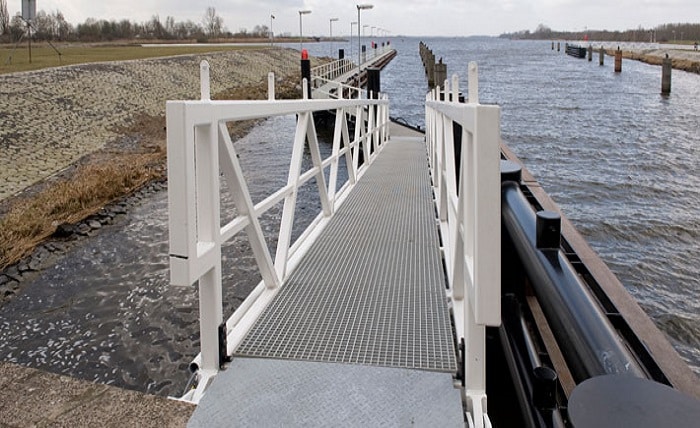Introduction
In recent years, FRP jetties have quickly gained traction across Australia’s marine construction industry. As the need for durable, sustainable, and cost-effective marine infrastructure grows, Fiber Reinforced Polymer (FRP) jetties have emerged as the preferred solution, especially for industrial projects near saltwater environments. With unparalleled resilience and lower maintenance needs, these jetties are revolutionizing the sector and offering marine contractors and engineers a reliable, eco-conscious alternative to traditional materials.
What Makes FRP Jetties Stand Out in Marine Applications?
The Composition and Benefits of FRP Jetties
FRP, or Fiber Reinforced Polymer, is a composite material made from reinforced fibers embedded in a polymer matrix. This unique composition creates a jetty material that can withstand corrosion, high salt levels, and the constant wear and tear of marine environments, all while maintaining structural integrity over time. The material’s inherent resistance to rust and weathering makes FRP particularly valuable in coastal and port areas, where traditional materials like steel, concrete, and wood often require intensive upkeep or early replacement.
Traditional Materials vs. FRP: A Smart Switch
Compared to conventional materials, FRP jetties provide notable advantages. Wooden jetties are prone to rot, while steel jetties suffer from rust and require constant repainting. Even concrete, though initially strong, is vulnerable to cracking and spalling in marine conditions. By contrast, FRP jetties offer durability without the need for chemical treatments, coatings, or heavy repairs. This minimizes disruption to the surrounding environment and reduces the overall life-cycle cost of maintenance—a major benefit for industrial projects that prioritize efficiency and long-term savings. You can explore more about the advantages of FRP jetties.
The Practical and Environmental Benefits of FRP Jetties
Eco-Friendly Advantages of FRP Jetties
Beyond their physical durability, FRP jetties are also environmentally friendly. Unlike materials treated with toxic chemicals or preservatives, FRP does not leach harmful substances into marine ecosystems, making it a safer option for areas that need to prioritize water quality and marine life health. Additionally, because FRP jetties require less frequent maintenance and fewer replacements, they reduce waste production and carbon emissions over time. For contractors and industrial clients, this eco-benefit aligns with a growing focus on sustainable marine solutions that minimize ecological impact while maximizing service life.
Cost Savings Over Time
Initial investments in FRP jetties might be slightly higher than those for traditional materials, but the long-term savings are significant. Thanks to their inherent strength and weather-resistant properties, FRP jetties demand less frequent maintenance, repairs, and replacements. In fact, industrial users have found that FRP products can offer a 30–50% reduction in maintenance costs over their lifespan compared to other options. With labor costs rising, the ability to cut down on maintenance visits or repair work can lead to substantial financial benefits, especially in Australia’s demanding marine climate.
Real-World Applications of FRP Jetties in Australia
FRP Jetties in Action Across Australian Shores
Australia’s coastline and ports have increasingly incorporated FRP jetties across a wide array of applications, from industrial wharves to recreational marinas. In major ports, FRP jetties serve as a reliable infrastructure that can endure heavy foot traffic and high tidal flows without deteriorating. Private marinas, meanwhile, benefit from FRP’s sleek, modern look that doesn’t compromise on strength or longevity. For both public and private sectors, FRP jetties provide a viable alternative to traditional materials, especially in areas where maintenance and downtime are costly.
Case Studies and Examples
Across Australia, several key projects have demonstrated the durability and environmental benefits of FRP jetties. For example, a recent installation in a high-salt, high-humidity coastal area has shown minimal signs of wear and required no significant maintenance after years in operation. Another project highlighted how FRP jetties reduced construction time and provided faster installation compared to conventional materials, allowing the team to complete the work well ahead of schedule. These case studies highlight how FRP’s unique qualities make it ideal for challenging marine settings, where reliability and resilience are essential.
Projecting the Future of FRP Jetties in Marine Infrastructure
Why FRP Jetties Are Set to Grow
The increasing demand for sustainable, durable, and low-maintenance materials in marine construction has solidified FRP jetties as a key future component in Australia’s marine infrastructure. Industry predictions indicate that FRP adoption will continue to grow as government initiatives push for greener, more cost-effective solutions. Furthermore, FRP’s ability to reduce lifetime project costs aligns with economic trends that favor resilient infrastructure investments, particularly in coastal development projects.
Potential Challenges and Opportunities for FRP Adoption
Despite their advantages, FRP jetties face challenges in terms of initial awareness and adoption. While the upfront cost of FRP might be a deterrent, educating stakeholders on the long-term savings and sustainability of FRP jetties can encourage wider acceptance. With more companies sharing the benefits and successes of FRP projects, awareness of this material’s unique value is spreading. As marine industries become more aware of FRP’s benefits, adoption will likely increase, making it a more standard option in infrastructure planning and construction.
Conclusion
FRP jetties are reshaping the landscape of marine infrastructure, offering a sustainable, durable, and cost-effective alternative to traditional jetty materials. Their ability to withstand Australia’s harsh coastal climate, minimize maintenance, and support eco-friendly construction makes FRP jetties an excellent choice for any industrial marine project. For contractors, engineers, and stakeholders in the marine sector, FRP jetties offer a solution that meets the demands of today and anticipates the needs of tomorrow.





